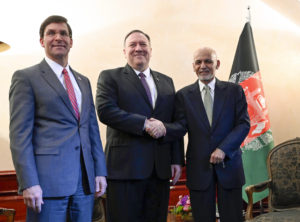The Media Needs to Radically Change the Way It Covers ‘Foiled Terror Plots’
Mindlessly repeating sensationalist FBI framing isn't journalism—it’s fear-mongering. An FBI police car. (Tony Hisgett / CC BY 2.0)
An FBI police car. (Tony Hisgett / CC BY 2.0)
This holiday week, we saw yet another high-profile “foiled” terror plot. And once again, when one looks closely at the government’s case, it consists of an FBI ruse, driven largely by the government itself. According to The Washington Post, the suspect, Demetrius Pitts, “indicated to [an] FBI employee he did not want to detonate any bombs himself” and the FBI special agent in charge “conceded it was unclear whether Pitts had the means to carry out an attack by himself.” The FBI even gave Pitts a bus pass and a cellphone so he could “carry out” the entirely theoretical attack on an Independence Day parade in Cleveland.
But right on cue, the average American was met with the routine barrage of sexed-up headlines, giving one the distinct impression an organic, al-Qaida-driven plot had been stopped at the eleventh hour. Since 9/11, the chasm between the reality of so-called Islamic State or al-Qaida plots and the way the public perceives the threat is light-years apart. The media should—and can—work to reduce this chasm if it chooses to use the slightest bit of critical reasoning and political context.
Human rights groups and independent researchers have found between 67 percent and 99 percent of nominal terror cases involve varying degrees of FBI involvement, often with the bureau acting as the primary engine—providing materials, plans and encouragement to a “suspect,” often after he or she merely expresses pro-jihadist sympathies online. The gap between idle internet musing and actual acts of violence is a wide one, and one the FBI routinely helps close by constructing these Potemkin plots. Frequently, informants or agents working for the FBI outnumber the suspects being targeted by three, four or five to one and provide the funding and targets for the attack. The FBI and its 15,000-strong network of informants particularly enjoy constructing those plots involving major holidays and new, previously unthinkable targets—presumably in an effort to raise the stakes and get an increasingly terror-fatigued public to notice.
Yet one wouldn’t know there was no actual imminent threat by scanning the headlines, which only 40 percent of Americans read past. Often, the fact that the FBI is a driving force behind these “plots” is buried deep in the story, as is the case again this week with coverage from CNN, Forbes, Fox News and CBS News on the alleged plan for a Cleveland attack.
But headlines are the most important element of stories, and cable news—which is little more than headlines being yelled at the public on a loop—engages in the same type of shallow, government-parroting fear-mongering. The vast majority of Americans are simply unaware of the degree to which these are not plots that would otherwise be carried out, but creations of a network of informants and agents building a trap for a target, very often one that’s poor, black and suffering from a history of mental illness.
None of this, of course, is to say that every plot is cooked up in some FBI whiteboarding session. Often the line between organic and contrived terror plot is difficult to distinguish, and statistically speaking it’s almost certain some percentage of those caught in the FBI’s crosshairs would have committed an act of violence at some point. But the most basic reading of many of these high-profile cases would leave any reasonable person with the impression these are not actual terror plots in any real sense. And the public has a right to know this, without having to get into the weeds of obscure, difficult-to-read government affidavits.
The media doesn’t simply report the news. It shapes our perception of it. To simply repeat the FBI “foiled a plot” without noting in the headline that the FBI was responsible for creating the plot is intellectual malpractice.
Take the case of Emanuel Lutchman of Rochester, N.Y. A similar holiday-themed “thwarted attack” occurred on New Year’s Day 2016. It involved a mentally unwell indigent man. An FBI informant drove him to Walmart to buy supplies for the attack and provided the $40 for the “terror” materials because the man didn’t have a car or enough money for his own murder-suicide. The headlines at the time screamed “News Year’s Eve terror plot” over and over, but every detail of the case showed how exploitative and thin it was, up to and including the FBI’s informant talking Lutchman into the attack after he wanted to back out at the last minute.
Or look at the case of the “Draw Muhammad Contest” plot in Garland, Texas—an actual terror attack that involved live fire and the main suspect, Elton Simpson, being killed in a hail of bullets in 2015. This too involved undercover FBI agents telling the suspect to “tear up Texas” days before the attack and a mysterious FBI agent who was present when the attack took place, standing just feet behind Simpson. Even the security guard injured in the attack, to this day, blames the FBI for letting the plot spiral out of control.
Now compare this with the hyperventilating coverage of Garland, which gave the impression that Islamic State cells were everywhere in our midst. It wasn’t until months later, after court documents came to light, that we learned the level of FBI involvement. This is a consistent pattern: Initial reports—based solely on an FBI press release and statements—downplay government influence and make the plot seem like the work of an elaborate Islamic State or al-Qaida sleeper cell network. Then, when the case (or related cases) go to trial, the extent to which informants or agents advanced the plot becomes too glaring to ignore.
To what extent the FBI has a hand in creating the image of perma-terror that it and it alone can stop is rarely centered in coverage of these so-called plots. The fact is it’s essential. Anyone who studies these cases with any degree of skepticism knows this. The idea that the FBI eggs on, provides inert weapons for and helps map out these plots is not a controversial point. It’s a key element to the bureau’s “proactive” approach to stopping what it views, fairly or not, as emerging threats.
However, the public has a right to know the deceptive nature of these sensationalist stories, and how often and how much the FBI itself is driving the impression that terror threats lurk around every corner.
Your support matters…Independent journalism is under threat and overshadowed by heavily funded mainstream media.
You can help level the playing field. Become a member.
Your tax-deductible contribution keeps us digging beneath the headlines to give you thought-provoking, investigative reporting and analysis that unearths what's really happening- without compromise.
Give today to support our courageous, independent journalists.









You need to be a supporter to comment.
There are currently no responses to this article.
Be the first to respond.